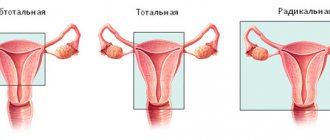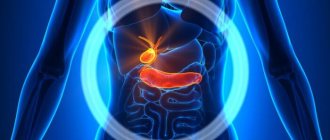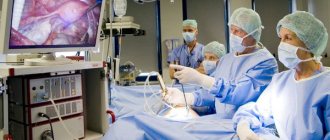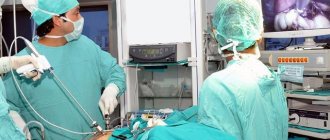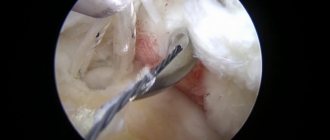The NT-Medicine clinic takes part in the compulsory medical insurance program and provides planned surgical care, both in a hospital setting and on an outpatient basis, for various diseases to residents of the Kostroma, Ivanovo, Vologda, Vladimir, Arkhangelsk, Tver regions , patients from Moscow and the Moscow region , and others regions .
The list of operations that are performed in a 24-hour hospital for patients with a compulsory medical insurance policy (CHI):
Attention! Doctor's consultation, preoperative examination and tests are not included in the list of compulsory medical insurance services!
Traumatology and orthopedics:
- Arthroscopic surgeries on the knee, shoulder, ankle joints
- Reconstructive foot surgery
- Metal osteosynthesis
- Injection of synovial fluid into the prosthetic joint
- Arthrodesis
- Endoprosthetics of large joints
- Arthromedullary – bypass surgery of the knee and ankle joints
- Corrective osteotomies of the lower leg bones;
- Suture of the heel (Achilles) tendon and other tendons and ligaments
- Hand operations
What are the advantages of urological operations
Laparoscopic operations have several advantages over open techniques:
- shorter rehabilitation period;
- excellent cosmetic results (no large scars or cicatrices);
- the patient’s condition is not so severe for a long time;
- fewer complications, including infectious ones.
Laparoscopy in urology involves working with a magnification of 10-30 times, which allows him to clearly see even the smallest anatomical structures. Modern endovideo cameras provide images in HD quality. Thanks to this, the doctor is able to perform surgical procedures more carefully and accurately, and this reduces the amount of blood loss, trauma to surrounding tissues and the risk of complications.
Thus, the patient remains in the intensive care unit for only a few hours and requires little or no pain relief. Even after laparoscopy, you can start walking and eating earlier, as well as return to your normal life.
Oncology (including for residents of the Yaroslavl region)
- Removal of external malignant tumors with reconstruction of skin defects
- Radical surgical treatment of breast cancer
- Restorative reconstructive plastic surgery on the mammary gland after radical treatment of the tumor
- High-tech operations for tumors of the internal female genital organs
- Endoscopic operations for tumor stenoses of the biliary tract
- Installation of port systems for chemotherapy
- Chemotherapy courses for cancer of various locations
- Radical treatment of tumors of the male genital organs
- Endoscopic removal of polyps of the stomach and colon
To provide assistance within the framework of compulsory medical insurance, you need to call or write to the chief physician of the NT-Medicine clinic, Sim Mikhail Illarionovich, by phone (SMS, Viber, WhatsApp) or by email
8 [email protected]
A response to your request will be provided to you within two business days.
Conditions for the provision of medical services under the compulsory medical insurance policy:
- presence of a Russian passport,
- availability of a compulsory medical insurance policy (except for the Yaroslavl region),
- availability of SNILS,
- referral for hospitalization in form 057/u-04 with all fields filled in, doctor’s signature and stamp, seal of the medical organization in your region operating in the compulsory medical insurance system to which the patient is geographically attached,
- The results of a clinical examination with current dates required for hospitalization for the purpose of surgical treatment.
- results of testing for COVID-19 using the PCR method (can be done in our clinic according to the current price list)
For patients under the compulsory medical insurance policy, stay in the clinic and food are provided free of charge.
You can undergo the necessary pre-hospital examination in our NT-Medicine Clinic.
Laparoscopy before IVF
Methods of surgical gynecology before IVF can increase the effectiveness of the procedure. “Nova Clinic” is equipped with the latest equipment, and our specialists have many years of successful experience in performing such operations, so we are able to significantly increase the effectiveness of the procedure even at the stage of preparation for in vitro fertilization.
Laparoscopy before IVF is necessary in order to eliminate certain factors that may serve as an obstacle to successful implantation and further development of embryos. These include uterine fibroids, ovarian cysts, foci of endometriosis or chronic infections of the pelvic organs. In addition, laparoscopy, by removing pathologically altered sections of the fallopian tubes, can prevent such a dangerous complication as ectopic pregnancy.
Carrying out laparoscopy before IVF makes it possible to adjust the treatment regimen and, as a result, significantly increase the chances of a successful attempt. We get the opportunity to identify all possible negative factors and eliminate them in advance, thereby creating the most favorable conditions for the attachment of the embryo to the walls of the uterus and its subsequent development. The presence of a focus of chronic infection is often the cause of miscarriage, since the embryo can be poisoned by toxins produced as a result of the activity of pathogenic microorganisms. It must be borne in mind that conservative therapy will not give the expected effect if the source of infection has not been eliminated surgically.
Diagnostic laparoscopy of the fallopian tubes allows us to identify a chronic pathological process that can cause the development of ectopic pregnancy after IVF. Often, excision of adhesions can increase the chances of pregnancy.
Uterine fibroids and ovarian cysts must be removed because they tend to actively grow during the gestational period, which can lead to serious complications.
Laparoscopy before an IVF fertilization program makes it possible to identify and remove foci of endometriosis, which is one of the main causes of infertility. Thanks to timely intervention, it is possible to stop the pathological process, preventing damage to neighboring organs and tissues: ureters, rectum, etc.
Thus, laparoscopy is a method that can simultaneously significantly increase the effectiveness of infertility treatment using ART methods and significantly reduce the likelihood of complications during pregnancy. That is why, before conducting an ART program, it is necessary to do a laparoscopy and, if necessary, eliminate factors that could negatively affect the outcome of IVF and the course of pregnancy. If necessary, we also perform surgery to remove the fallopian tubes.
Regimen after laparoscopy
Unlike traditional operations, bed rest after laparoscopy is no more than a day. A two- to three-day hospital stay is possible at the patient’s request, but for medical reasons this is rarely required. At the same time, during the healing of the wound, the woman practically does not experience various painful sensations, so there is no need to use strong painkillers, especially narcotic analgesics.
Many patients are concerned about the problem of preventing pregnancy after laparoscopy. It is recommended to select contraceptives based on consultation with a specialist. At the same time, some women completely unreasonably believe that after the operation some time must pass before conceiving a child. Laparoscopy, as a rule, is performed so that a woman can become pregnant. In general, we can say that after laparoscopy there is no special regimen that must be strictly observed. The only thing that is necessary is to carefully monitor your health and undergo regular examinations by a qualified gynecologist.
Kidney removal - laparoscopy
A modern, minimally invasive and safe method of kidney removal is laparoscopy. With this intervention, all actions are performed inside the body with long instruments. To create the free space necessary for action, carbon dioxide is pumped into the abdominal cavity. The instruments are passed through 5 or 10 mm incisions in the abdominal wall. Incisions of this size usually require 1-2 stitches each after surgery is completed. Ports for 3 instruments are standardly installed: a video camera and lighting through a port near the navel, and 2 working instruments through ports in the iliac region and along the midline of the body between the navel and sternum. Sometimes, if the operation is performed on the right kidney, it becomes necessary to install a fourth port. An instrument passed through it is needed to lift the liver upward to open access to the kidney.
First, the area of the organ's hilum is isolated, clipped, and the renal artery and vein are divided. After this, the surgeon separates the kidney along with the perinephric tissue from the surrounding tissues and places them in a container in which the organ will be removed from the body through an extended port incision in the iliac region. The operation ends with the installation of a safety drain in the operation area.
| On the instrument there is a renal artery, below is a vein. | Applying a clip to the renal artery. |
Performing laparoscopic nephrectomy will be extremely difficult or impossible if the patient has previously had extensive surgery on the abdominal organs, especially due to trauma or peritonitis. After them, a pronounced adhesive process is almost always observed. Also, laparoscopic kidney removal may not be feasible for large tumors. In this case, the possibility of surgery is decided individually.
Laparoscopic operations performed at the Urology Clinic of the First Moscow State Medical University named after. Sechenov:
- Laparoscopic radical prostatectomy
- Laparoscopic radical nerve-sparing prostatectomy
- Laparoscopic and extraperitoneoscopic partial nephrectomy
(removal of part of the kidney) - Laparoscopic nephrectomy
(kidney removal) - Laparoscopic radical cystprostatectomy
(bladder removal) - Laparoscopic nephroureterectomy (removal of the kidney and ureter)
- Laparoscopic plastic surgery of the ureteropelvic segment
- Laparoscopic and extraperitoneoscopic excision of the walls of a kidney cyst
- Laparoscopic ureterolithotomy
(ureteral stone removal) - Laparoscopic adenomectomy
(removal of prostate adenoma) - Laparoscopic clipping of the spermatic vein
(for varicocele)
Advice for patients
- It is worth applying for VMP at the beginning of the year. At the end of the year, hospitals apply for government funding for a certain number of robot-assisted surgeries, which comes in at the beginning of the year. If you apply for VMP at the end of the year, you risk facing a lack of quotas.
- Carefully choose the clinic where you want to have surgery. She must have a special VMP license, as well as unallocated budgetary operations.
- Research information about suitable clinics in other regions of the country. You can get on the waiting list at different medical institutions, but the commission for each will need to be completed individually.
- Monitor the status of the coupon on the website.
What is laparoscopy
Laparoscopy is a minimally invasive surgical procedure designed to treat organs located in the pelvic and abdominal area. Surgical intervention leaves almost no traces and effectively combats existing pathologies. It is performed using small punctures that provide access to the affected area. Next, a laparoscope with a special camera is used, which transmits a detailed image of the internal organs.
Indications and contraindications for laparoscopy

An operation such as laparoscopy is indicated in the following cases:
- pelvic adhesions;
- inflammation of the uterine appendages;
- cysts in the ovaries;
- gallbladder polyps;
- stomach and duodenal ulcers;
- cholelithiasis.
Article on the topic: Features of a temporary compulsory health insurance policy
The list of indications is quite extensive; it may include diseases from different areas of medicine. All of them are treated free of charge under the compulsory medical insurance policy upon appropriate treatment.
At the same time, invasive intervention cannot be performed in the following cases:
- the presence of malignant tumors;
- severe blood loss;
- cardiovascular or renal failure;
- severe diabetes mellitus;
- obesity above stage 3;
- critically low body weight;
- blood clotting disorder.
Surgery is undesirable in case of persistent increase in blood pressure, as well as emerging exacerbations of chronic diseases. In these cases, laparoscopic intervention is not performed according to compulsory medical insurance, postponing laparoscopy until the patient is stabilized.
Features of the procedure
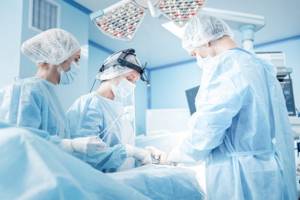
A medical program involving laparoscopy requires general anesthesia. However, during endoscopic intervention, the doctor may limit itself to the use of local anesthesia. Also, epidural anesthesia is sometimes used during laparoscopy, which leaves the patient conscious. The sensitivity of the lower part of the body is switched off through the introduction of a catheter into the space of the spine.
The compulsory medical insurance policy allows you to perform free operations in various fields of medicine: gynecology, urology, oncology. Laparoscopy is used to eliminate gastrointestinal diseases, excision of hernias, etc. Usually the operation lasts 1.5-2 hours, but the time depends on the specific affected area.
Laparoscopy under the compulsory medical insurance policy makes it possible to perform a planned operation. In gynecology, this occurs on certain days of the menstrual cycle, preferably after ovulation. A categorical contraindication is surgical intervention during menstruation; it can result in infection and internal bleeding.
Possible consequences

The following complications may occur when performing laparoscopy:
- Injury to internal organs or blood vessels. This outcome is especially likely in patients whose body weight is close to low.
- Tissue burn. This may occur due to the action of the electrodes, which deliver current to the tissue. If the surgeon notices the problem late, trauma cannot be avoided.
- Hypothermia. Laparoscopy is performed using cold carbon dioxide, prolonged exposure to which leads to hypothermia.
Related article: Compulsory medical insurance - problems and ways to solve them
If the procedure is performed incorrectly, there is a risk of developing internal bleeding or bacterial peritonitis.

